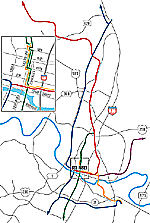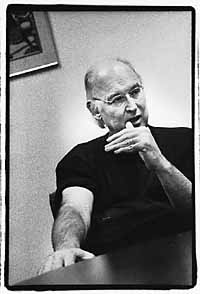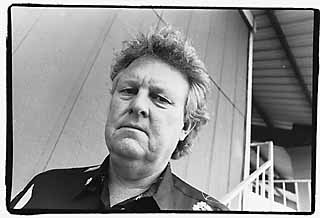Which Way Do We Go?
Rae Takes the Wheel
By Mike Clark-Madison, Fri., April 9, 1999
Then again, Cap Met's disarray makes it easier for Rae to change the agency's culture, mindset, and direction, which was certainly her mandate from the board that hired her. This change goes deeper than cleaning up Capital Metro's history of medieval autarchy and petty dishonesty. Listening to Rae, it's clear that she views Cap Met's role in Austin's transportation future differently than did her predecessors, especially where light rail is concerned.
"A rail-only solution is not a solution," she says. "Light rail will only be an effective tool if the community wants it. We could have a light-rail system that compares with the best in the country, but do people want it? I'm not of the build-it-and-they-will-come school."
Cap Met would still like to build a rail system, but previous regimes viewed rail as a self-evident necessity and the ultimate justification for Capital Metro's existence and taxing authority, and devoted much time and energy into planning a system the community still views skeptically. "We have a dozen technical studies and all the basic info we need on rail options," Rae says, "as well as 162 miles of rail line itself (the Llano-Giddings corridor owned by the agency). But we want to take the work that's been done before and bring it to the decision point. I sense that the community is ready to make a decision and get on with it."
To make a valid decision, Rae and the Cap Met board feel, we need to consider a range of options and make genuine comparisons. "I want to get apples-to-apples data out to the public -- rail vs. buses vs. highways," she says. "And we need to see what our transportation future would look like if we had no rail. It's easy to say 'no' to rail when you don't know what the alternative would be."
It needs to be noted that Capital Metro is already in the funding pipeline with the Federal Transit Administration for a rail system, and is moving forward with its application for "new starts" money even as the AIM process puts a question mark next to light rail. "We need to ensure that we don't lose our place in line," says Rae, "but we also want to strengthen our project by building the community consensus that the FTA expects. They don't want us to use their money to move full-steam-ahead on a project that doesn't have community support."
While legislation passed in 1997 (which the Krusee bill would amend) authorizes Capital Metro to hold an up-or-down referendum on light rail itself, the AIM process will likely point to an array of transportation strategies: rail within the city, bona fide commuter rail (perhaps under the aegis of the nascent Austin-San Antonio commuter rail district) between Central Texas communities, high-occupancy vehicle (HOV) lanes on our highways (already being planned for I-35), more and different bus routes and perhaps "busways" (bus-only lanes on major streets), and road expansion and improvement funded by Cap Met. Nor are we bound by the alignments and routings advanced in the past for rail: the Red Line, Green Line, Orange Line, and Blue Line (see map). "I'm attempting through this process to remain color-blind," Rae says.
"The big question we want to answer is what our public-transportation plan should accomplish," she continues. "What do we want our city to look like? And what can public transportation do to accomplish that? We need to put everything we know, and that we learn through this public process, into that context."
Behind the Times
Both Rae and her bosses -- the local elected officials and citizen appointees of the Capital Metro board -- are careful not to call the AIM process starting from scratch. But it only takes a little common sense to realize that, in the words of Cap Met board member and Austin City Councilmember Daryl Slusher, "anything that Capital Metro did in the past is deeply suspect to the taxpayers. It was simply a sad, totally dysfunctional, totally irresponsible agency.
 "I think we are behind where we ought to be, and it's a shame we have to go through this process before we move forward," Slusher concedes. "But the processes that Capital Metro went through before were deeply flawed, [and] we can't simply move forward with the plans that were drawn up by an unaccountable agency operating in a vacuum."
"I think we are behind where we ought to be, and it's a shame we have to go through this process before we move forward," Slusher concedes. "But the processes that Capital Metro went through before were deeply flawed, [and] we can't simply move forward with the plans that were drawn up by an unaccountable agency operating in a vacuum."
If Karen Rae is Ms. Inside, charged with climate change within the agency, Lee Walker is Mr. Outside, tasked with reminding the community that Capital Metro is actually its property. One of the board's two citizen members (the other is former Austin councilmember John Trevino), Walker -- UT professor, "reluctant investor," original Dellionaire, and central-city neighborhood mandarin -- was recently named "Austinite of the Year" by the Chamber of Commerce, evidence that local opinion leaders think he's doing something right. (He disclaims this. "I think they just ran out of names," he says. "At the ceremony, I was struck by the fact that all the previous honorees were people I'd actually heard of before. I doubt many of them had ever heard of me.")
Walker's constant self-deprecations and long-acquired air of spaciness obscure his real, valuable contribution to Cap Met -- a big-picture perspective. "I think we need to look at the next 100 years when we talk about what to do right now," he says. "For some people now, it's self-evident that we need light rail now and that's their point of departure. But what will Austin look like in 100 years, if our population has quadrupled? Our responses need to come from that perspective."
Cap Met is only one of many entities which will shape the city over those decades, and even aside from the transit authority's cheap and trashy missteps and mistakes, it's always been handicapped by its own lack of clarity about what, exactly, its role is supposed to be in a growing and maturing urban region. "The most damaging critique of the old Capital Metro was that it was so insular," Walker says.
"One of our goals now, and I think we're making progress, is to try to be as seamless as possible working with our partners -- with CAMPO (the Capital Area Metropolitan Planning Organization, the former Austin Transportation Study), with the city, with businesses, with the neighborhoods," Walker continues. "We can't be the single agency that controls what Austin does to improve mobility. But we can be a very powerful catalyst, because we have the talent and resources to make mobility improvements happen across the board."
Trying to Mesh Two Plans
The relationship between Capital Metro and CAMPO -- which appointed Walker -- is an interesting one. It is the CAMPO staff and board -- composed of an even larger assemblage of elected officials from cities, counties, and the state, and chaired by state Sen. Gonzalo Barrientos -- that crafts Austin's overall regional transportation plan, of which Capital Metro is an obviously substantial part.
The current version of the CAMPO plan, approved in 1994, presumes that 54 miles of "fixed-guideway transit," the jargon for light rail (or busways), will be built by 2020, which is no longer a wise thing to presume. Since MPOs -- creatures of federal highway legislation -- are required to update their plans every five years, CAMPO is currently updating its plan, at the same time as Cap Met is planning its future, a decision that may still be pending when the CAMPO plan is finalized in December.
Having two separate, but mutually dependent, planning efforts is at best a pain in the butt, though both Cap Met and CAMPO say they're trying to work together. "We want the efforts to mesh, because our plan will be the official regional plan, and they'll have to follow it like any other jurisdiction," says CAMPO director Michael Aulick. "I think it will help that our plan will go through 2025, and they're currently looking at the next five or 10 years. ... What's important is that they don't cut off any options that we may need to pursue in the future."
As far as Aulick and CAMPO are concerned, light rail is an essential piece of that future. "If our growth continues the way we think it will [and] the Austin area doubles in population by 2025, something like rail or busways is about the only way we can go, because major expansion of the urban highways isn't feasible," says Aulick.
Those 54 miles of rail in the1994 plan helped keep the lid on projected expansions of I-35 and MoPac; without rail, Aulick feels, "we'd need 12 lanes on I-35, and that's really expensive and disruptive and involves tearing down too many buildings." It's scary assessments like that which would be part of the non-rail "Plan B" that Capital Metro wants citizens to see as part of the AIM process. "I think having a plan that presumes 54 miles of rail actually puts rail at a disadvantage now," says Karen Rae. "We need to explain that no rail means bigger roads."
Bona fide transit advocates echo Aulick's assessment that a major transit system is not optional. "People need to understand that rail is and has to be an integral part of our long-range plan," says Karen Akins, executive director of the Trans Texas Alliance. "We have to assume that it's going to happen, and we don't even know if that will provide us with enough mobility."
Understandably, transit supporters are a little irked that Capital Metro is willing to, in their view, soft-pedal, and perhaps completely abandon, rail in the face of political pressure. "Cap Metro doesn't need to be in the business of selling anything," says RAIL Austin leader Will Bozeman. "They need to follow through on what the community's position and vision is, and the community has already considered rail and included it in its transportation plan."
The Naysayers' Turn?
|
|
The de facto leader of their camp is Gerald Daugherty, leader of the ROAD (Reclaim Our Allocated Dollars) effort against Capital Metro's tax collection and prime citizen advocate of the Krusee bill. "This community does not embrace Capitol Metro building or engineering anything," he says. "Even if we think something should happen, we don't trust Capital Metro to make it happen."
Daugherty is not swayed by the AIM effort, for reasons that are ironically similar to those of his ideological opposites. "After 14 years and $800 million, you'd think they'd know what to do," he says. "This planning effort is going to be a bunch of bull, because every 'town meeting' will include 14 Cap Met staff members, six rail advocates, 13 architects and land planners with a vested interest in rail, and maybe one Gerald Daugherty.
"There's no doubt in my mind that if Lee Walker has his way, we will start building light rail tomorrow," he continues. "And if you ask the citizens whether they want to spend $700 million on a 16-mile stretch of light rail, it'll make the S.O.S. vote look close." (Walker dismisses such talk as "scurrilous nonsense," adding, "I'm not sure I've ever been on a light-rail system. Why would I be trying to shove something down the citizens' throats that I personally know next to nothing about?")
Though Daugherty often gets dismissed by transit advocates as an idiot, he's probably right when he says that "over my years of fighting with Capital Metro, I've come to know as much about public transportation as [S.O.S. leaders] Bill Bunch and Mary Arnold do about the Barton Creek watershed." But over the years, the anti's have frustrated observers with their seemingly shifting targets. In 1997, Daugherty memorably told the now-deposed old Cap Met board, "Light rail is not the problem; Capital Metro is the problem" -- the prelude to months of scrutiny of agency mismanagement and poor performance. Those problems are, by even skeptics' estimation, receding into Cap Met's past under its new management.
So now light rail is the problem -- "It's smoke and mirrors," Daugherty notes. "We need something that's more practical and that doesn't use so much of our money, which we need for so many other things. There's nothing 'mass' about Capital Metro except its budget. We have definitely got to have a public transit system, but we need it to operate on half a cent [of sales tax] and let the community decide what to do with the other half."
What Krusee Wants
Which takes us to the Krusee bill, which would give Daugherty his wish. If passed, the agency would have to hold a referendum this November with two propositions -- one allowing Cap Met to collect 1*4 cent of sales tax for light rail, the other allowing it to collect 1*4cent for highway projects. If neither passes, then the agency would only be able to collect a half-cent of tax, as opposed to the full cent that it collects now. While there's definitely less momentum behind the bill than there proved to be behind 1997's Cap Met bills, wise men and women will not place bets against the Krusee bill or some variation thereof.
There's no denying that the Krusee bill has some appealing qualities -- it would allow for a straight up-or-down vote on light rail in general, instead of on a specific proposal, as well as a chance for anti-road voters to express their displeasure with projects like SH130 at the ballot box. Since Cap Met is already committed to taking light rail to the voters, and since its board has already expressed its intent to roll back the tax if light rail loses, "there's nothing to be gained by being nasty" about the Krusee bill, says Rae. "It's consistent with what we've been preaching; it's just the approach that causes some concerns."
|
|
Among those concerns is using for highways, especially highways like SH130 that will mostly run outside the Cap Met service area, money that the authority feels it needs for bus service. "I don't think you can run the buses on a half-cent, and I think this money was intended for transit and shouldn't be going to highways," Slusher says. "But my problem with the Krusee bill is that the Legislature created the new board -- you didn't hear me campaigning to be on the Capital Metro board -- and we have turned the agency around. For the Legislature to come in now and take away our local control is not sound public policy and isn't in the best interest of the transportation future of Central Texas."
The inflexibility of the half-a-cent here, quarter-cent there Krusee approach also troubles the agency and other observers. "I think that's a recipe for getting insufficient, lower-quality rail and highway projects," says Rae. And Richard Hamner, chief of staff for Sen. Barrientos, argues that, "we're just now amending [the CAMPO] plan, and it's premature to say 'Here's how you should divide the money up.'" Hamner also notes that the Krusee scheme would leave no money left over for projects like Austin-San Antonio commuter rail, which enjoys Barrientos' strong support.
Between the Krusee bill, the AIM effort, the CAMPO planning effort, and other things, we'll all be talking a lot about public transportation here for the next few months. We've already got at least two City Council candidates positioning themselves as "the anti-light-rail candidate," and we've got the City's Smart Growth effort, which includes its own set of not-without-controversy "transit corridors." And we've even got specific projects like the Convention Center, the Seaholm Power Plant conversion, the CSC/City Hall deal, and perhaps most notably the Robert Mueller redevelopment, all of which incorporate and depend on a transit system Austin does not actually have.
Last time transit was the topic du jour, of course, Cap Met nearly got abolished and became synonymous with ineptitude and sleaze, and it's sort of remarkable that they're still in a position to have any control over their own destiny. But it's probably true that this time around, once we're done with the AIM process and all the surrounding dialogue, we'll be ready to finally move forward on a middle-of-the-road transportation plan.
"Our mission is to provide the best transportation system we can," says Rae. "Light rail can be part of that system. We're obligated to do a public process, but I think it's appropriate that it have a time limit and not go on forever. We believe we need to take one last look at the community's views and make a decision now -- one that's not just a Capital Metro decision, or else it'll be doomed to failure. Our goal is to get this discussion moving forward rapidly so that we can all get on with our lives."
Got something to say on the subject? Send a letter to the editor.










